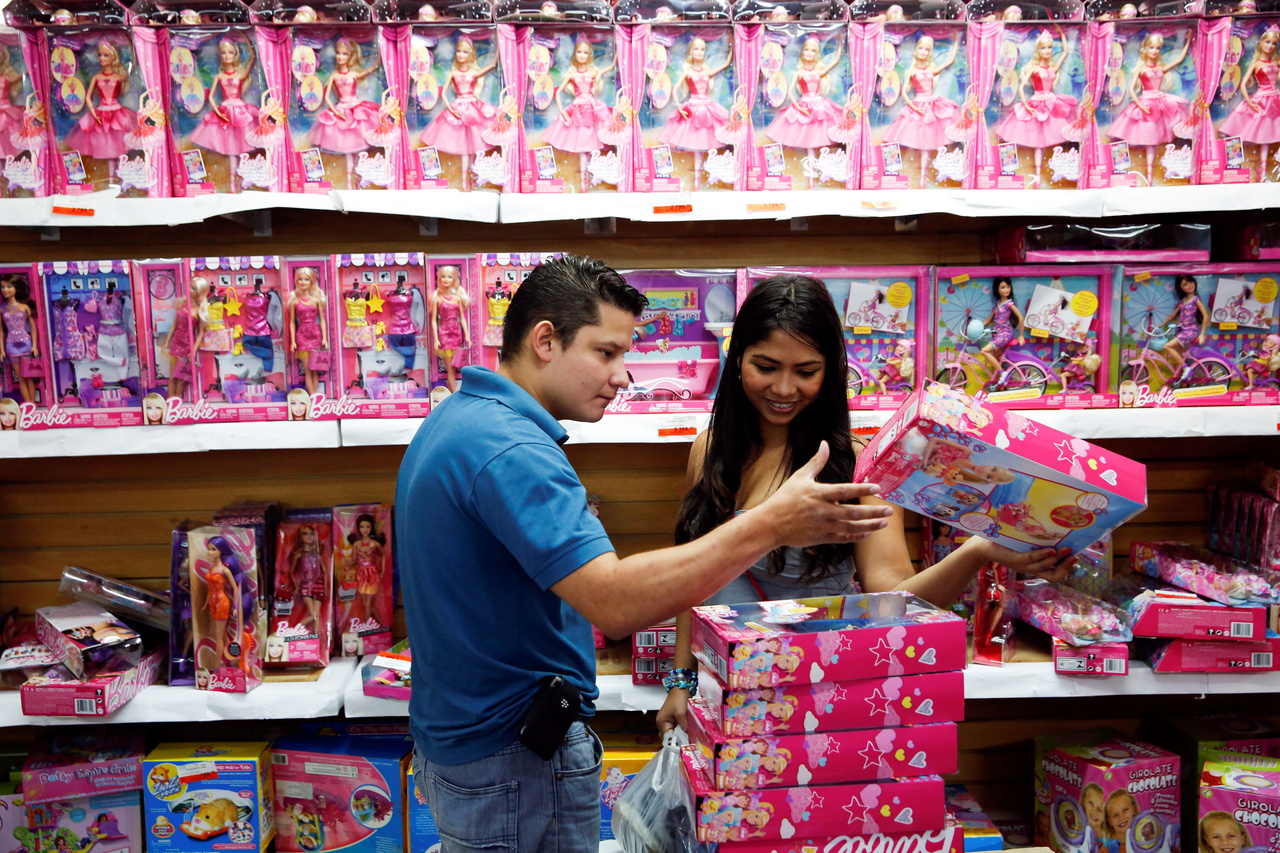The Asian Voice
The not-so-innocent side of mass-produced toys: Daily Star contributor
The writer says the mimicry of the adult world via toys conditions children to conform to societal norms.
Sign up now: Get insights on Asia's fast-moving developments

People look for dolls at a toy store in Caracas, on Nov 14, 2014.
PHOTO: REUTERS
Noora Shamsi Bahar
Follow topic:
DHAKA (THE DAILY STAR/ASIA NEWS NETWORK) - We don't normally think of toys from a critical perspective because, well, they're just toys. But if one were to reflect on it, one might become easily disenchanted by these children's playthings.
For starters, mass-produced toys are imitation pieces that are basically miniature versions of the real world-"a microcosm of the adult world," as Roland Barthes put it.
You have toys in the form of humans wearing miniature versions of clothing, shoes, and accessories. You have miniature doll houses with bedrooms, bathrooms, living rooms, and kitchens. In each of these little imitation spaces are miniature furniture and appliances. There are miniature versions of transportation-cars, bikes, helicopters, aeroplanes, ships, boats, etc. I could go on.
But what does this world of imitation do? It enables children to have what's already present in the adult world and they "identify as owner, as user, never as creator" (Barthes).
Moreover, this mimicry of the adult world conditions children to conform to societal norms. For instance, children may develop characteristics driven by gender roles, based on the toys given to them. Action figures of superheroes, a staggering majority of which are male, are given to boys, and that drives home the point that men are supposed to be strong.
Then there are imitation pots and pans (the oh-so-familiar hari-patil set) that every South Asian girl has received as a child, which prepare her to be the homemaker she is meant to be when she grows up.
Haven't all Bangladeshi girls enjoyed a bit of putul khela (playing dolls), which must have undoubtedly included putuler biye-pretending that it is the doll's wedding day (sometimes even in the absence of a male doll)? The idea that the most important day of a Bangladeshi girl's life is her wedding day is thus drilled into her at an age when she cannot even comprehend the idea of marriage.
And thus, the mirroring of the flawed adult world conditions children so that they can neither think for themselves, nor have their own preferences.
Furthermore, the "goodwill" of toymakers of mass-produced toys is profit-driven. Mattel, American toymaker and creator of Barbie, didn't come up with a doll that promoted inclusivity because that was not the concern in the 50s.
However, since 2016, Barbie went through major changes and is currently available in all colours, shapes, hair types, and features. Mattel probably realised that the Americans themselves-let alone the rest of the world-no longer wish to buy the original fair-complexioned Barbie with her long blonde hair, large blue eyes, baby pink lips, and unrealistic body proportions.
Perhaps mothers who were once obsessed with Barbie would think twice before buying Barbie for their daughters, knowing too well that this doll promotes impossible, fantastical body and beauty standards, which in turn lead to low self-esteem issues in its consumers: young, impressionable girls.
Did Mattel reinvent Barbie for more sales? A sceptic would think so. And so now you'll see a Black girl asking for the dark-complexioned Barbie with a black afro or a differently-abled girl wanting the Barbie that comes with a wheelchair. The inclusivity of different physical characteristics in the many versions of Barbie is, in my opinion, a business strategy.
Last but not the least, mass-produced toys are not unique. I recently watched a show based on real events, called "Manhunt: Unabomber," and came to understand the psyche of the serial bomber Ted Kaczynski and his anarchist manifesto entitled "Industrial Society and its Future," which projects the ideology that technology is the bane of human existence, because it destroys nature and makes us lead controlled lives (devoid of freedom).
Episode 6 showed how Kaczynski made a Kalimba-a small, handheld musical instrument-with his own hands, in his cabin in the woods, which he wanted to present to a bullied boy he had befriended, who had invited him to his birthday party. Before entering the home of this boy, Kaczynski saw him opening a present-a mass-produced miniature/imitation piano, manufactured by a multi-million-dollar industry.
The boy was excited over a symbol of the industrial revolution-the very object of Kaczynski's loathing. Shattered, Kaczynski walked away without giving the boy the present he had handcrafted.
Toy keyboards are found in every toy store, and you probably had one presented to you on one of your birthdays, which was trashed sooner or later, because the excitement over it wore out and there was some other "cool" toy to obsess over.
If mass-produced toys didn't exist, perhaps kids would value handmade toys and/or find joy in creating their own toys/games from the organic things found in nature-stones, clay, or wood!
- Noora Shamsi Bahar is a senior lecturer at the Department of English and Modern Languages in North South University (NSU). The Daily Star is a member of The Straits Times media partner Asia News Network, an alliance of 23 news media organisations.

